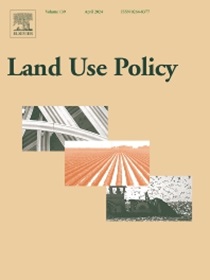Has rural depopulation reduced agricultural land use efficiency? Mediating roles of cropland abandonment, scale operation, and cultivation structure
IF 5.9
1区 社会学
Q1 ENVIRONMENTAL STUDIES
引用次数: 0
Abstract
Large-scale outmigration of the rural population has reshaped the patterns of agricultural land use. However, the pathways through which rural depopulation (RDP) affects the agricultural land use efficiency (ALUE) remain unclear. This study analyzes 220 prefecture-level cities in China that experienced significant rural population outflows between 2000 and 2020. A super-efficiency SBM model accounting for undesirable outputs is employed to measure ALUE, followed by an analysis of its spatiotemporal patterns. A panel Tobit model is then used to examine the relationship between RDP and ALUE. Finally, the mediating roles of cropland abandonment, scale operation, and cultivation structure are explored. The results show that ALUE has exhibited a fluctuating downward trend over time, with southern regions performing better than northern ones. RDP significantly hinders improvements in ALUE, and this relationship remains robust after a series of robustness and endogeneity tests. Mechanism analysis reveals that cropland abandonment, scale operation, and cultivation structure serve as mediating factors in the impact of RDP on ALUE. This study highlights the importance of the dynamic evolution of human–land relationships in shaping land use performance. The findings offer valuable policy implications for improving land use efficiency under RDP and provide useful insights for governance practices in other regions facing similar challenges.
农村人口减少是否降低了农业土地利用效率?耕地撂荒、规模经营和耕作结构的中介作用
农村人口的大规模外迁重塑了农业用地格局。然而,农村人口减少(RDP)影响农业土地利用效率(value)的途径尚不清楚。本研究分析了2000年至2020年间农村人口大量外流的220个地级市。采用考虑非期望产出的超效率SBM模型对value进行测度,并对其时空模式进行分析。然后使用面板Tobit模型来检查RDP和value之间的关系。最后,探讨了退耕、规模经营和耕作结构对农业发展的中介作用。结果表明,随着时间的推移,value呈现波动下降趋势,南方地区表现优于北方地区。RDP显著阻碍了价值的提高,在一系列稳健性和内生性检验后,这种关系仍然是稳健的。机制分析表明,撂荒、规模经营和耕作结构是RDP对价值影响的中介因素。这项研究强调了人地关系动态演变在塑造土地利用绩效中的重要性。研究结果为提高RDP下的土地利用效率提供了宝贵的政策启示,并为面临类似挑战的其他地区的治理实践提供了有用的见解。
本文章由计算机程序翻译,如有差异,请以英文原文为准。
求助全文
约1分钟内获得全文
求助全文
来源期刊

Land Use Policy
ENVIRONMENTAL STUDIES-
CiteScore
13.70
自引率
8.50%
发文量
553
期刊介绍:
Land Use Policy is an international and interdisciplinary journal concerned with the social, economic, political, legal, physical and planning aspects of urban and rural land use.
Land Use Policy examines issues in geography, agriculture, forestry, irrigation, environmental conservation, housing, urban development and transport in both developed and developing countries through major refereed articles and shorter viewpoint pieces.
 求助内容:
求助内容: 应助结果提醒方式:
应助结果提醒方式:


